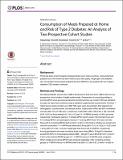| dc.contributor.author | Zong, Geng | en_US |
| dc.contributor.author | Eisenberg, David M. | en_US |
| dc.contributor.author | Hu, Frank B. | en_US |
| dc.contributor.author | Sun, Qi | en_US |
| dc.date.accessioned | 2016-08-09T14:54:35Z | |
| dc.date.issued | 2016 | en_US |
| dc.identifier.citation | Zong, Geng, David M. Eisenberg, Frank B. Hu, and Qi Sun. 2016. “Consumption of Meals Prepared at Home and Risk of Type 2 Diabetes: An Analysis of Two Prospective Cohort Studies.” PLoS Medicine 13 (7): e1002052. doi:10.1371/journal.pmed.1002052. http://dx.doi.org/10.1371/journal.pmed.1002052. | en |
| dc.identifier.issn | 1549-1277 | en |
| dc.identifier.uri | http://nrs.harvard.edu/urn-3:HUL.InstRepos:27822362 | |
| dc.description.abstract | Background: There has been a trend towards increased dining out in many countries. Consuming food prepared out of the home has been linked to poor diet quality, weight gain, and diabetes risk, but whether having meals prepared at home (MPAH) is associated with risk of type 2 diabetes (T2D) remains unknown. Methods and Findings: We followed 58,051 women (from 1986 to 2012) and 41,676 men (from 1986 to 2010) in two prospective cohort studies of health professionals. Frequencies of consuming midday or evening MPAH were assessed at baseline and during follow-up. Incident T2D was identified through self-report and confirmed using a validated supplementary questionnaire. During 2.1 million person-years of follow-up, 9,356 T2D cases were documented. After adjusting for demographic, socioeconomic, and lifestyle factors, hazard ratios (HRs) and 95% confidence intervals (95% CIs) of T2D were 1 (reference), 0.93 (0.88–0.99), 0.96 (0.90–1.03), and 0.86 (0.81–0.91) for those eating 0–6, 7–8, 9–10, and 11–14 MPAH (p-trend < 0.001) per week, respectively. Participants eating 5–7 midday MPAH had 9% lower T2D risk than those with 0–2 midday MPAH, and participants having 5–7 evening MPAH had 15% lower risk than those with 0–2 evening MPAH (both p-trend < 0.001). In the first 8 y of follow-up, women and men who consumed 11–14 MPAH per week had 0.34 kg (95% CI: 0.15–0.53; p < 0.001) and 1.23 kg (95% CI: 0.92–1.54) less weight gain than those with 0–6 MPAH, respectively. Among participants who were nonobese (body mass index [BMI] < 30 kg/m2) at baseline, pooled HR (95% CI) of developing obesity (BMI ≥ 30 kg/m2) was 0.86 (0.82–0.91; p-trend < 0.001) when extreme MPAH groups (11–14 MPAH versus 0–6 MPAH) were compared. When midday and evening MPAH were analyzed separately, HRs comparing extreme groups (5–7 MPAH versus 0–2 MPAH) were 0.93 (95% CI: 0.89–0.97, p-trend = 0.003) for midday MPAH and 0.76 (95% CI: 0.70–0.83; p-trend < 0.001) for evening MPAH. Further adjusting for BMI during follow-up attenuated the association between MPAH and T2D risk: the HR (95% CI) for participants with 11–14 MPAH was 0.95 (0.89–1.01, p-trend = 0.13). The main limitations of our study were that it lacked assessments on individual foods constituting the MPAH and that the findings were limited to health professionals with a relatively homogeneous socioeconomic status. Conclusions: In two large prospective cohort studies, frequent consumption of MPAH is associated with a lower risk of developing T2D, and this association is partly attributable to less weight gain linked with this dining behavior. | en |
| dc.language.iso | en_US | en |
| dc.publisher | Public Library of Science | en |
| dc.relation.isversionof | doi:10.1371/journal.pmed.1002052 | en |
| dc.relation.hasversion | http://www.ncbi.nlm.nih.gov/pmc/articles/PMC4933392/pdf/ | en |
| dash.license | LAA | en_US |
| dc.subject | Biology and Life Sciences | en |
| dc.subject | Physiology | en |
| dc.subject | Physiological Processes | en |
| dc.subject | Eating | en |
| dc.subject | Medicine and Health Sciences | en |
| dc.subject | Endocrinology | en |
| dc.subject | Endocrine Disorders | en |
| dc.subject | Diabetes Mellitus | en |
| dc.subject | Metabolic Disorders | en |
| dc.subject | Food Consumption | en |
| dc.subject | Behavior | en |
| dc.subject | Habits | en |
| dc.subject | Smoking Habits | en |
| dc.subject | Physiological Parameters | en |
| dc.subject | Body Weight | en |
| dc.subject | Weight Gain | en |
| dc.subject | Obesity | en |
| dc.subject | Nutrition | en |
| dc.subject | Diet | en |
| dc.subject | Food | en |
| dc.subject | Public and Occupational Health | en |
| dc.subject | Physical Activity | en |
| dc.title | Consumption of Meals Prepared at Home and Risk of Type 2 Diabetes: An Analysis of Two Prospective Cohort Studies | en |
| dc.type | Journal Article | en_US |
| dc.description.version | Version of Record | en |
| dc.relation.journal | PLoS Medicine | en |
| dash.depositing.author | Zong, Geng | en_US |
| dc.date.available | 2016-08-09T14:54:35Z | |
| dc.identifier.doi | 10.1371/journal.pmed.1002052 | * |
| dash.contributor.affiliated | Eisenberg, David | |
| dash.contributor.affiliated | Zong, Geng | |
| dash.contributor.affiliated | Sun, Qi | |
| dash.contributor.affiliated | Hu, Frank | |


